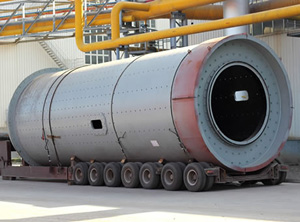Cement mills is the largest user of electric power on a cement
plant, and because they can easily be started and stopped, it often pays to
operate cement mills only during 'off-peak' periods when cheaper power is
available. This is also favourable for electricity producers, who can negotiate
power prices with major users in order to balance their generating capacity over
24 hours. 
More sophisticated arrangements such as 'power shedding' are often employed. This consists of the cement manufacturer shutting down the plant at short notice when the power supplier expects a critical demand peak, in return for favourable prices. Clearly, plenty of excess cement milling capacity is needed in order to 'catch up' after such interruptions. Cement clinker is usually ground using a ball mill. This is essentially a large rotating drum containing grinding media - normally steel balls. As the drum rotates, the motion of the balls crushes the clinker. The drum rotates approximately once every couple of seconds.
The drum is generally divided into two or three chambers, with different size grinding media. As the clinker particles are ground down, smaller media are more efficient at reducing the particle size still further. Grinding clinker requires a lot of energy. How easy a particular clinker is to grind ('grindability') is difficult to predict, but rapid cooling of the clinker is thought to improve grindability due to the presence of microcracks in alite and to the finer crystal size of the flux phases.
It is frequently observed that belite crystals, which have a characteristic round shape, tend to separate and form single crystal grains during grinding. A cement mill is an installation used to grind the clinker component of concrete. Clinker is a hard, nodular material produced by sintering aluminosilicate and limestone in a cement kiln. There are several cement mill types which are able to grind clinker of which the ball mill is the most common.
tube ball mill: http://www.bestjawcrusher.com/products/tube_mill/
| 리버풀 이야기 축구 이야기 자유 게시판 포토 갤러리 축구 동영상 잘 부탁드립니다 | 최근 댓글 |
